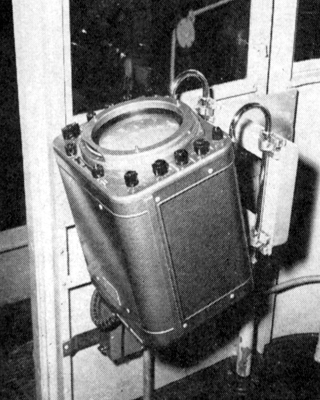On the 9 inch viewing screen of the "Indicator" unit, mounted in the pilot house to the left of the wheel, a selector switch gives the viewer 6 different Range Scales to choose from as he observes. This means that a round picture somewhat similar to what you would see from the air directly above the ship, and with the ship as its center-point, can be changed to include all objects within a 10 mile scale or reduced to as low as the 1/2 mile scale giving a much larger image of objects within that limited radius. In connection with this Range Scale a further improvement in the Decca River Model is the off-centering of the radar picture. One drawback of the regular marine-type radar is that with the ship represented at the exact center of the picture that portion of the picture showing conditions astern is mostly wasted. Unlike the Naval Captain who uses his radar screen to detect the presence of enemy craft from all bearing points around his ship, the Fireboat Pilot under way in fog, dense smoke or heavy rain wants to know what dangerous objects lie ahead, not which ones he has safely passed. When off-centering is used the center of the picture is moved toward the lower or near edge of the screen so that some of the portion of the picture, which is of little value, is cut off by the tube and added to the picture ahead, thus giving increased warning area.
Another improvement in the newly acquired unit has to do with Bearing Discrimination. Two objects can be as close together as 10 yards or differ in bearing by no more than 1.2 degrees and still be shown on the radar screen as clearly separated. Objects, or "targets," on any radar screen are, of course, far from being clearly defined as in a good television picture.
 Both Fire Boat No. 2 and Fire Boat No. 1 are now equipped with radar units. Their operation is not appreciably different in any way so far as the units are concerned. Chief Gifford states that, ". . . in the past it's been a combination of a lot of handling skill and good luck that has avoided accidents with the Boats in periods of low visibility." He said further that the added safety and efficiency factors brought about by the radar installations on the two Boats was well worth the 15,314 dollar cost. Both Fire Boat No. 2 and Fire Boat No. 1 are now equipped with radar units. Their operation is not appreciably different in any way so far as the units are concerned. Chief Gifford states that, ". . . in the past it's been a combination of a lot of handling skill and good luck that has avoided accidents with the Boats in periods of low visibility." He said further that the added safety and efficiency factors brought about by the radar installations on the two Boats was well worth the 15,314 dollar cost.
The men on the Fire Boats have lost no time in sharpening up on the operation of the new equipment, and they've had some fun in the process. They no longer start cranking the engine-room bells to avoid a sea gull sitting on the water two points off the star board bow.
"A" shift Pilot Gordon Woodman is one of the men who did a lot of leg work and research on radar use prior to written recommendations to the Administration Office. As "Woody" puts it, "The important thing is to be thoroughly familiar with your physical surroundings so that you can quickly recognize the more or less sketchy objects on the screen. Like you landlubbers say--know your district!"
A lot of thought and planning went into the study of just what type and make of radar equipment would be most efficient and practical for use on the L.A.F.D. Fire Boats. Questionnaires were sent to agencies using radar both at sea and on inland waterways such as the U.S. Coast Guard, Fish and Game Services, and several large Fire Departments, having harbor areas in their protection districts. Information from theses replies coupled with officially witnessed demonstrations arranged for by the Harbor firemen resulted in an intelligent approach to getting the wheels turning toward this big step in increased Fire Department efficiency.
|